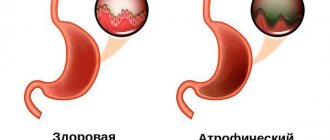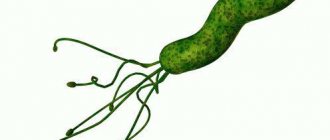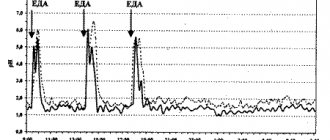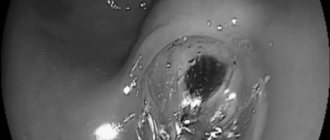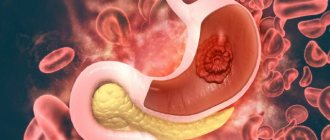Story
The study of gastric achylia is associated with the detection of atrophy of the gastric mucosa. The English doctor Fenwick (S. Fenwick, 1877) described 4 cases of atrophy of the gastric mucosa, confirmed by autopsy. Many researchers note that with atrophy of the gastric mucosa, hydrochloric acid and enzymes are absent. However, Einhorn (M. Einhorn, 1892) showed that gastric achylia is observed even without atrophic changes in the gastric mucosa; it can be a consequence of nervous disorders. This point of view was adhered to by Martius (F. Martius, 1892), who described the so-called idiopathic achylia, which, as he believed, was based on the congenital functional weakness of the secretory apparatus of the stomach.
A major contribution to the study of various aspects of the separation of gastric juice was made by I. P. Pavlov and his students (K. M. Bykov, 1947; I. M. Kurtsin, 1953; Yu. M. Lazovsky, 1948; I. P. Razenkov, 1948; Ya. P. Sklyarov, 1961; B. P. Babkin, 1960). The discovery of the basic patterns of neurohumoral regulation and cyclic activity of the gastric glands was of great importance for the development of normal and pathological physiology of the stomach, including in the study of the problem of gastric achylia.
It is customary to distinguish between two main types of gastric achylia - functional and organic.
Prevention methods
To prevent gastric achylia, it is enough to follow simple rules, which include:
- proper nutrition;
- giving up bad habits;
- normalization of work and rest regimes;
- elimination of emotional stress;
- timely detection of gastrointestinal diseases.
Gastric achylia, the types and features of which are listed in this article, belongs to the category of diseases with a favorable prognosis. To avoid negative consequences, at the first alarming symptoms you should consult a gastroenterologist. Confirming the diagnosis means following the diet and other recommendations of the treatment specialist. The earlier the patient starts therapy, the more effective it is.
Functional achylia
With functional achylia
the glandular apparatus of the stomach is preserved, but due to negative mental and other factors, hydrochloric acid and pepsin are not separated.
From the point of view of the teachings of I.P. Pavlov and his students, functional achylia of the stomach is explained by inhibition of the secretory function of the gastric glands due to disruption of cortical dynamics, disruptions of conditioned reflex activity that occur during nervous tension, intoxication, and prolonged mental trauma. Functional achylia of the stomach can be a consequence of a violation of the diet, insufficiency of protein in the diet, certain types of vitamin deficiency or hypovitaminosis (scurvy, pellagra, sprue). A decrease in the secretory activity of the gastric glands can be observed when the body overheats.
One of the manifestations of functional achilia is heterochilia, when in the same person, in response to the same test stimulus, upon repeated examination, different states of the secretory apparatus of the stomach can be detected: achilia, hypochilia and hyperchilia. According to a number of authors (for example, A. G. Gukasyan), heterochilia is more often observed in individuals with functional disorders of the nervous system, especially at a young age. Other authors (M. P. Konchalovsky, 1911; G. L. Levin, 1968; A. S. Belousov, 1969) believe that an increase and decrease in gastric secretion is not a persistent symptom, and therefore the accepted acidity standards have only relative value.
Diet
Diet plays an important role in the treatment of achylia. Raw and poorly fried meat, meat of old animals with a large amount of connective tissue (tough) are excluded from the patient’s diet. Patients do not tolerate whole milk or raw eggs well; raw fruits and especially their peels, as well as some types of vegetables (radishes, radishes, raw carrots, sauerkraut) cause exacerbation of intestinal disorders in these patients. As a rule, patients are also prohibited from fried meat, especially fatty goose, duck and canned food, smoked sausage, smoked fish, and marinades.
The prohibition of the listed nutrients limits dietary treatment, and the patient is otherwise allowed any food according to his taste. However, it is very advisable not to eat a lot at a time and take food in smaller quantities, but more often, so as not to overload the intestines with undigested food.
In more severe cases of achylia, when functional disorders of the intestines in the form of chronic diarrhea come to the fore, dietary treatment is especially important, and the diet becomes more strict and limited. When prescribing a diet, it is necessary to keep in mind not only the components of the food, but also the form and method of preparing it.
As a rule, food, especially meat and plant foods, containing a lot of connective tissue and cellulose, should be served in crushed form, meat - in the form of cutlets, balls, meatballs; vegetables and fruits - in the form of puree; buckwheat porridge - in the form of a slurry.
Due to the fact that raw vegetables and fruits are poorly tolerated, but still contain substances that enhance the secretion of gastric juice, and also vitamins, it is recommended that instead of raw vegetables and fruits, give juice squeezed from them, for example, cabbage, potato or spinach; This also includes radish juice, carrot juice, and especially orange and lemon juice. Soups should be prescribed in the form of mucous or puree soups; decoctions of vegetables (cabbage, beets) strained with sour cream are recommended; eggs are not raw or hard-boiled. Hot and spicy substances are prohibited: pepper, onion, garlic, mustard, vinegar and canned food. Fats allowed are cream, butter, and olive oil.
Organic achilia (anadenia)
Organic achilia (anadenia)
is a consequence of irreversible damage to the glandular apparatus of the stomach with cessation of the secretion of hydrochloric acid and pepsin. Irreversible morphological changes in the mucous membrane may be a manifestation of a primary disease of the glandular apparatus of the stomach (atrophic gastritis), and then they speak of primary organic achylia of the stomach. Secondary organic achylia of the stomach occurs in neoplasms, intoxications, chronic diseases of the liver and biliary tract, endocrine diseases (diabetes mellitus, hypothyroidism, diffuse toxic goiter, Addison's disease).
Clinical picture
The clinical picture of functional gastric achylia may not appear for a long time, especially with good compensatory function of the pancreas and intestines. The patient's complaints are nonspecific: vague pain in the epigastric region, especially after eating large quantities of food; fast fatiguability; increased irritability. Achylia of the stomach in such cases is detected by chance.
With organic achylia of the stomach, a number of objective symptoms appear associated with changes in the functions of the stomach and involvement of the liver and bile ducts in the pathological process. Disturbances in the biliary tract system, together with pancreatic insufficiency, manifest as steatorrhea, creatorrhea and polyfecalia, cause intestinal dyspepsia, and increase fermentation and putrefactive processes. In the absence of hydrochloric acid and pepsin, exogenous infection penetrates the intestines, dysbacteriosis and infectious diseases develop. Pain in the epigastric region can be explained by a circulatory disorder in the wall of the stomach in the form of venous stasis, mainly in the area where the intragastric nerve ganglia are located (P. N. Stepanov). Disruption of hydrolytic processes, increased absorption of large fragments of protein molecules in the inflamed small intestine with reduced barrier function of the liver lead to the development of sensitization of the body (O. L. Gordon); Perhaps this explains intolerance to eggs, fish, crayfish, milk and some other foods. Achylia of the stomach is often accompanied by weight loss, decreased body resistance, and anemia due to impaired absorption of vitamin B12, iron and copper. Due to impaired absorption of vitamins and mineral salts, pellagra, osteoporosis, and ariboflavinosis may develop.
Possible complications
Ahilia is a serious disease, the treatment of which doctors do not recommend neglecting. A long-term pathological process can lead to the development of complications. Among them, the most dangerous are the following:
- chronic gastritis;
- gastric oncology;
- cryptogenic pernicious anemia.
Some complications appear at an early stage of the disease, others develop only against the background of cessation of secretory activity. The pathology itself rarely leads to death. However, the occurrence of these complications increases the likelihood of adverse consequences.
Diagnosis
The diagnosis is made on the basis of laboratory and instrumental studies. It is important to determine the state of the secretory function of the gastric glands (presence or absence of hydrochloric acid and pepsin), the type of gastric achylia. In case of organic achylia of the stomach, it is necessary to determine whether it is primary or a consequence of another, sometimes serious, disease. To diagnose functional and organic achylia of the stomach, methods of multi-stage study of gastric secretion, radiotelemetric determination of pH and enzymatic activity of the stomach contents are used, especially against the background of submaximal and maximum stimulation of the secretory apparatus of the stomach with histamine (see Histamine test). Comparison of the data from these analyzes with the results of a study of basal secretion makes it possible to judge the role of functional and organic factors in secretory disorders of the stomach (Yu. I. Fishzon-Ryss). Detection of gastric achylia in middle age, and even more so in the elderly (senile gastric achylia), is alarming regarding a possible precancerous condition or stomach cancer.
Of great importance in the diagnosis of functional and organic Achilles of the stomach is gastrofibroscopy (see Gastroscopy) with targeted or so-called linear biopsy of the gastric mucosa [Kimura, Takemoto (K. Kimura, T. Takemoto), 1970], with histochemical and enzymological studies of the biopsy material. Radiologically, with organic achylia of the stomach, a rough relief of the mucous membrane and significant smoothness of the contours of the stomach, accelerated evacuation and often the presence of single or multiple polyps are noted.
Diagnosis of pathology
If gastric achylia is suspected, the doctor will recommend the patient to undergo laboratory and instrumental tests:
- Stool analysis. This study allows you to identify undigested elements. In addition, such an analysis allows us to exclude dysbacteriosis.
- Blood analysis. Makes it possible to detect hemoglobin levels and suspect inflammatory processes.
- Acidotest. The patient is given a pill to drink that contains a special indicator. The latter has the ability to be released in the stomach and then excreted in the urine. In this case, the liquid is colored, depending on the state of the gastric juice, in the appropriate color. The rich color of urine indicates a high concentration of dye and indicates a hyperacid state. A light shade means anacid.
- pH-metry. A special probe with a sensor is inserted through the esophagus into the stomach cavity. It allows you to measure the acidity of the organ.
- Fibrogastroscopy. Using a probe inserted into the stomach, the doctor determines the condition of the mucous membrane, assesses the reaction and the amount of gastric juice. In addition, the procedure allows you to take a tissue sample for histological examination.
- Contrast radiography. The study is performed using a contrast solution. When fluid fills the stomach, the doctor takes an x-ray. The images can reveal changes in the relief of the mucous membrane and diagnose ulcers or neoplasms.

